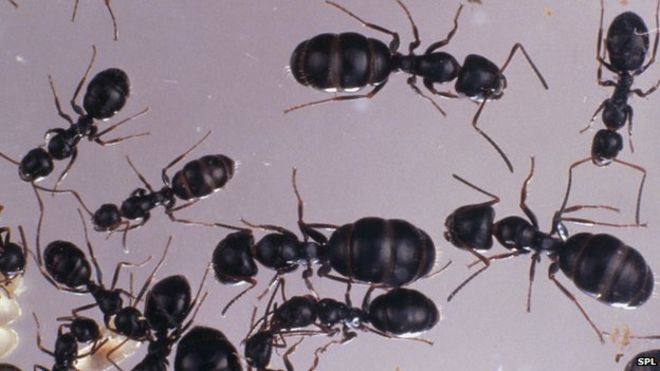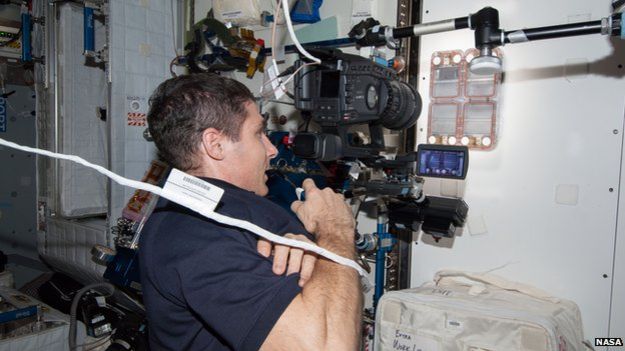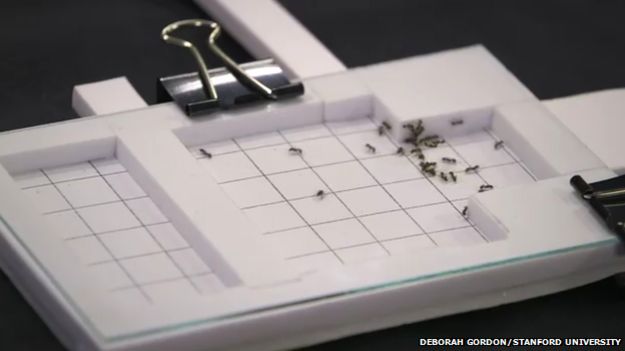Ants in space grapple well with zero-g
 There are 14,000 ant species and we know little about their different "collective search" strategies
There are 14,000 ant species and we know little about their different "collective search" strategiesAnts carried to the International Space Station were still able to use teamwork to search new areas, despite falling off the walls of their containers for up to eight seconds at a time.
Their "collective search" was hampered but still took place, biologists said.
The insects also showed an impressive knack for regaining their footing after taking a zero-g tumble.
Researchers want to learn from the ants' cooperative methods and develop search algorithms for groups of robots
The ants were sent aloft in a supply rocket in January 2014, and results from the experiments are published in the journal Frontiers in Ecology and Evolution.
The team is now beginning a citizen science project where schoolchildren can help collect data from other ant species - in their classrooms, rather than up in space.
Speaking to the BBC's Science in Action, senior author Deborah Gordon said that ants have demonstrated their remarkable collective abilities in myriad environments on Earth, but the results from the microgravity conditions of the Space Station were something new.
"We had no idea what the ants would do. We didn't know if they would be able to search at all," said Prof Gordon, a biologist at Stanford University.
As it turned out, although they had a little difficulty maintaining contact as they crawled, once adrift the ants showed a "remarkable ability" to get their six feet back on solid ground.
About 10% of the ants at any time were just floating aroundProf Deborah Gordon, Stanford University
"Sometimes they would grab onto another ant and climb back down... And sometimes, they somehow managed to just flatten themselves back onto the surface. I think the biomechanics of that are interesting," Prof Gordon said.
Testing times
The team sent up eight colonies of 80 common pavement ants, housed in small, transparent plastic boxes. Each container had a "nest" area where the animals lived.
To start the experiment, a barrier was removed that allowed them to explore a new area. After a few minutes, a second barrier was lifted, expanding the available territory even further.
"The idea is to ask the ants to search a small space - and then provide more space and see what will happen when the same number of ants have to use a larger space," Prof Gordon explained.
Equivalent experiments were also run back on Earth, for comparison.


The experiments were overseen by astronauts on the ISS and recorded by cameras
Down on ground level, adding extra space and dropping the "density" of ants caused them to adjust their paths, covering more ground and spreading out much more. In this way, nearly every corner of the container was visited by more than one ant within five minutes.
The ants in space still did their best to search, moving out into the expanded area as expected - but they were nowhere near as effective as their counterparts on the ground, which had the luxury of normal gravity.
Battling to keep their feet on the plastic surfaces, the space-ants tended not to spread out as effectively. And some parts of the new area never even encountered the patter of six tiny feet.
"The ants didn't do as well as they might have in microgravity," Prof Gordon said. "I think that's partly because the effort to hold on led to them moving more slowly, and so they didn't have a chance to cover the ground as thoroughly."
Adding to the problem was the fact that ants kept dropping off the surfaces altogether, tumbling in the air for periods lasting three to eight seconds. So the ants were constantly interrupted in gauging how far apart they were.
"I don't think it'd be that easy to use interactions to keep track of density, because about 10% of the ants at any time were just floating around - and so they were not really available to interact."
Call for help
When the history-making ants took their first steps in zero-g they were adding one more new environment to an already extensive list. It just happens to be a very new environment.
"There's not been a lot of evolution to shape their collective search in microgravity," Prof Gordon said.
By contrast, nearly every clime on Earth is inhabited by at least one of the 14,000 species of ant.
Different strategies have evolved in different places - for example, the European pavement ants that were taken into space tend to head straight for the edges of their new territory, while a species of Argentine ants, which the team studied previously, tends to work over fresh ground slowly and thoroughly, inch by inch. The researchers have provided instructions for school classes to test more ant species, here on Earth
The researchers have provided instructions for school classes to test more ant species, here on Earth
"All ants have to perform collective search and we don't know how they do it. There may be very interesting algorithms for collective search that we haven't discovered," Prof Gordon said.
Algorithms like these could help program robots to search in groups, without the need for a central control centre. And Prof Graham is asking for help to find out more about them.
She and her team have set up a website with instructions for school classes to run the same experiment, using equipment they can make themselves, on whatever species of ant are local to their area.
"We hope that kids around the world will try this same experiment with all of the many thousands of species of ants that have never been studied," Prof Graham said.
She has set up a website for sharing the results and hopes to build up a database of "how different species solve this problem differently" around the world.
There is no suggestion, yet, that any other species will get the chance to strut its stuff in space.
Down on ground level, adding extra space and dropping the "density" of ants caused them to adjust their paths, covering more ground and spreading out much more. In this way, nearly every corner of the container was visited by more than one ant within five minutes.
The ants in space still did their best to search, moving out into the expanded area as expected - but they were nowhere near as effective as their counterparts on the ground, which had the luxury of normal gravity.
Battling to keep their feet on the plastic surfaces, the space-ants tended not to spread out as effectively. And some parts of the new area never even encountered the patter of six tiny feet.
"The ants didn't do as well as they might have in microgravity," Prof Gordon said. "I think that's partly because the effort to hold on led to them moving more slowly, and so they didn't have a chance to cover the ground as thoroughly."
Adding to the problem was the fact that ants kept dropping off the surfaces altogether, tumbling in the air for periods lasting three to eight seconds. So the ants were constantly interrupted in gauging how far apart they were.
"I don't think it'd be that easy to use interactions to keep track of density, because about 10% of the ants at any time were just floating around - and so they were not really available to interact."
Call for help
When the history-making ants took their first steps in zero-g they were adding one more new environment to an already extensive list. It just happens to be a very new environment.
"There's not been a lot of evolution to shape their collective search in microgravity," Prof Gordon said.
By contrast, nearly every clime on Earth is inhabited by at least one of the 14,000 species of ant.
Different strategies have evolved in different places - for example, the European pavement ants that were taken into space tend to head straight for the edges of their new territory, while a species of Argentine ants, which the team studied previously, tends to work over fresh ground slowly and thoroughly, inch by inch.
 The researchers have provided instructions for school classes to test more ant species, here on Earth
The researchers have provided instructions for school classes to test more ant species, here on Earth"All ants have to perform collective search and we don't know how they do it. There may be very interesting algorithms for collective search that we haven't discovered," Prof Gordon said.
Algorithms like these could help program robots to search in groups, without the need for a central control centre. And Prof Graham is asking for help to find out more about them.
She and her team have set up a website with instructions for school classes to run the same experiment, using equipment they can make themselves, on whatever species of ant are local to their area.
"We hope that kids around the world will try this same experiment with all of the many thousands of species of ants that have never been studied," Prof Graham said.
She has set up a website for sharing the results and hopes to build up a database of "how different species solve this problem differently" around the world.
There is no suggestion, yet, that any other species will get the chance to strut its stuff in space.
Comments
Post a Comment